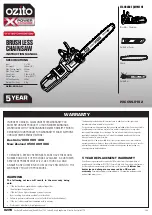
Plastoform screws are used in polymer components. These screws form a permanent thread when
they are installed for the first time. They can be removed and installed as often as necessary without
detrimentally affecting the strength of the screwed assembly, providing the specified tightening torque
is observed.
For this reason
always use a torque wrench.
Fastener
Thread
For component
Torque
Remarks
size
Nm
lbf.ft
Self-tapping screw
IS-B6.3x32
LH hand guard/motor housing
4.5
3.3
Slotted nut
M5 L
Drive pinion/rotor shaft
8.0
5.9
1)
Plastoform screw
IS-P3x10
Cover plate/sprocket cover
1.0
0.75
Plastoform screw
IS-P4.5x25
Commutator cover/motor housing
3.0
2.2
Plastoform screw
IS-P4.5x45
Stator/motor housing (1200 W)
3.0
3.0
Plastoform screw
IS-P4.5x55
Stator/motor housing (1400, 1600 W) 3.0
3.0
Plastoform screw
IS-P4x19
Oil pump/gear housing
2.5
1.8
Plastoform screw
IS-P4x19
Handle housing/motor housing
2.0
1.5
Plastoform screw
IS-P4x19
Cable clamp/motor housing
1.5
1.1
Plastoform screw
IS-P5x20
Spiked bumper/handle housing
4.0
3.0
Plastoform screw
IS-P5x20
Gear housing/motor housing
3.0
2.2
Spline screw
IS-M6x25
Brake band/gear housing
6.0
4.4
Use the following procedure to fit a ’P’ screw in an existing thread:
– Place the P screw in the hole and rotate it counterclockwise until it drops down slightly.
– Tighten the screw clockwise to the specified torque.
This procedure ensures that the screw engages properly in the existing thread and does not form a new thread.
1) Secure slotted nut with Loctite 242.
Note:
Screws/nuts secured with adhesive are easier to release if they are heated beforehand with a hot air blo-
wer (hairdryer).
Be careful with polymer components!
Power screwdriver speed settings for polymer: Plastoform screws max. 600 rpm,
DG screws
max. 500 rpm
2.4
Tightening Torques
4






































